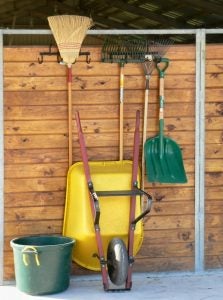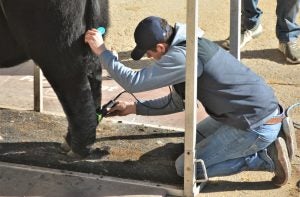Around the country, amid the hustle and bustle of last-minute summer plans, families are preparing for fairs. The diversity of items brought to fairs highlights the quality and variety of the local agricultural industry and showcases many hours of hard work. For exhibitors at the county fair, the upcoming events mean fun, friends, and ensuring that they’re ready before pulling out of the drive — because exhibiting is often about more than just fun. It’s a business endeavor.
»Related: The great 4-H debate: Which livestock barn is the coolest?

Read the rules
Whether you’re showing an indoor exhibit, livestock, or, perhaps, produce, it’s integral that you read, understand, and follow the rules. Fairs usually have exact specifications regarding shows and how they’ll be judged. Not following the rules may get you bumped down in a class or, worse, kicked out.
For livestock, you must read the rules ahead of time to ensure you’re following clipping and fitting rules, and that you’re showing up at the right time, prepared. Some things to look for: Can you clip at the show? Are show-day adhesives allowed? Is drenching allowed or not? What times should you show up to check in and weigh? Is there a disposition form you will be required to turn in before the sale — what is it, and when do you need to turn it in?
If you’re showing an indoor exhibit or poultry, knowing how to exhibit these items may also mean the difference in winning, losing, or getting the gate. If the rules state to display three of a baked item, then make sure you pick your best three items for entry. When exhibiting fresh produce, ensure you’re not cutting the tops off of carrots if the rules specify that they should be left on. Can you decorate your displays? If so, you may be able to make a quality item stand out? Or, do rules require that you leave these items plain-dressed to speak for themselves?
Prepare your equipment
Now’s the time if you haven’t cleaned and disinfected from the last jackpot. Who knows what clubby fungus or bacterial nastiness you brought home last time you hauled. An inch of prevention goes a long way, and this starts before exhibitors leave home.
To minimize the potential for disaster, clean and disinfect before you leave home:
- Feed equipment: buckets, hay racks, feeders, waterers
- Cleaning utensils: wheelbarrows, shovels, pitchforks
- Grooming equipment: clippers and brushes
- Vehicles and trailers: inside and out

Prepare your livestock
You’ve spent months raising animals to be the absolute best they can be. Like any good athlete, your livestock has spent months eating carefully-measured rations, training, and exercising. However, don’t drop the ball because you’re almost at your goal. There are some critical things to line up before you load into the trailer:
Entries. Check with your fair to ensure all your paperwork is completed, and turned in on time.
Paperwork. Many county and state fairs require that livestock is inspected before the show. This may include a brand inspection and a health inspection. Read ahead of time, and make sure to give your veterinarians and brand inspectors enough lead time — remember, they’re busy too!
Withdrawal periods. This is one that we cannot emphasize enough. If you’re raising livestock for food or as part of a business, make sure that you’re reading product labels well in advance of the fair. While certain products are integral to maintaining your animal’s health, they’re not considered a nutritional component on a consumer’s dinner plate. Also, some shows may drug test livestock, and a positive test could spell disaster for this fair year and many more to come. If the end goal for your market animal is to make the sale and sell, read and follow the withdrawals on labels.
Take animal health precautions. Are your animals hydrated, and are their guts in good shape? Reviewing your electrolyte programs and loading up on probiotics ahead of time may make for a better experience for you as an exhibitor, and for your livestock. Hydration is critical during warmer months of the year.

Exhibition is about a lot more than a ribbon
It’s no secret that the cost of everything has gone up. Even at the county level, purchasing, feeding, and showing livestock means significant investment for families, and with increasing costs, often comes increased pressure on exhibitors to do well. Even exhibiting indoor projects may mean a more significant investment in materials now than ever. Before the project begins, it’s crucial to set specific, attainable, measurable goals. Before you leave for the fair, it’s essential to do the same. Whether you’re taking home a rosette or a banner, or not, fairs are about a lot more than a ribbon:
Sportsmanship. One of the highlights of fair is watching older members help younger members and seeing youth take the time to congratulate each other. Twenty years down the road, the ribbons and banners aren’t going to matter, but memories, life skills, and friends are.
Skills. Preparation, hard work, and the ability to grow and create food, fiber, and fuel are fundamental skills for today’s youth. At the end of the day, many of these projects end up on someone’s dinner table — and that’s a massive win for any young producer.
Time with family and friends. Fair represents a time for many to reconnect with people with similar interests. Some of the best friends your kids may make are in their FFA and 4-H programs, and they may or may not be the ones they go to school with. Fair represents an opportunity to develop relationships and spend quality time with these people.

Don’t forget to have a little fair fun
Kids are kids, and what kids don’t enjoy rides and fair food? Set aside a little time and a few extra dollars in your budget to allow the kids (and adults) the time to unwind and play.
»Related: Georgia FFA member creates livestock show for special needs kids
Conclusion
As farmers and young entrepreneurs, a lot of preparation goes into fairs. The results, however, are well worth the work and time! With these preparation tips, you can avoid some of the hassles and enjoy a great time at the fair.
Heidi Crnkovic, is the Associate Editor for AGDAILY. She is a New Mexico native with deep-seated roots in the Southwest and a passion for all things agriculture.



